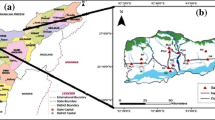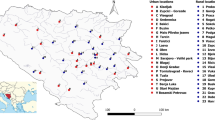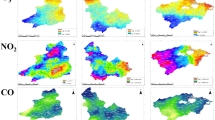Abstract
The accumulation of trace elements in the thalli of epiphytic lichens can reveal levels of trace elements in the ambient air. This study assessed the trace elements in lichen species Pyxine cocoes found in the urban and peri-urban areas of Kolkata. Trace elemental analysis was carried out using energy-dispersive X-ray fluorescence and proton-induced X-ray emission spectroscopy. Variable levels of elements like Mn, Fe, Cu, Zn, Cr, V and Pb, are detected in the thalli of P. cocoes collected from repressentative locations. Localization of trace elements in the thalli was confirmed by analysis using scanning electron microscope attached with EDX spectrometer. Several pollution indices such as enrichment factor, contamination factor (Cf) and pollution load index were estimated to evaluate the trace element contamination level of the ambient air at the sampling spots. PLI and Cf and values suggest deterioration or air quality that varies from moderate to high level of contamination. Ca, S, Pb, Sr and Cr, are highly enriched at urban sampling spots (1–9). High coefficient of variation values for Ca, S, Pb, Sr and Cr confirm their accumulation from local anthropogenic sources in the urban sampling spots (1–9). However, results of principal component analysis analysis have shown that sources of trace elements in the samples from urban areas include both vehicular emissions and anthropogenic activities. Higher concentration of trace elements in the lichen thalli collected from peri-urban locations is attributed to vehicular emissions from the highways and expressways running through these areas.








Similar content being viewed by others
References
Cohen AJ, Brauer M, Burnett R, Anderson HR, Frostad J, Estep K, Balakrishnan K, Brunekreef B, Dandona L, Dandona R, Feigin V, Freedman G, Hubbell B, Jobling A, Kan H, Knibbs L, Liu Y, Martin R, Morawska L, Pope CA, Shin H, Straif K, Shaddick G, Thomas M, van Dingenen R, van Donkelaar A, Vos T, Murray CJL, Forouzanfar MH (2017) Estimates and 25-year trends of the global burden of disease attributable to ambient air pollution: an analysis of data from the global burden of diseases study 2015. Lancet 389(10082):1907–1918
Sujetovienė G (2015) Monitoring lichen as indicators of atmospheric quality. Recent advances in lichenology. Springer, New Delhi, pp 87–118
Boonpeng C, Polyiam W, Sriviboon C, Sangiamdee D, Watthana S, Nimis PL, Boonpragob K (2017) Airborne trace elements near a petrochemical industrial complex in Thailand assessed by the lichen Parmotrema tinctorum (Despr ex Nyl) hale. Environ Sci Pollut Res 24(13):12393–12404
Parviainen A, Casares-Porcel M, Marchesi C, Garrido CJ (2019) Lichens as a spatial record of metal air pollution in the industrialized city of Huelva (SW Spain). Environ Pollut 253:918–929
Djingova R, Kuleff I, Markert B (2004) Chemical fingerprinting of plants. Ecol Res 19(1):3–11
Cabrera F, Clemente L, Barrientos ED, López R, Murillo JM (1999) Heavy metal pollution of soils affected by the Guadiamar toxic flood. Sci Total Environ 242(1–3):117–129
Kar S, Samal AC, Maity JP, Santra SC (2014) Diversity of epiphytic lichens and their role in sequestration of atmospheric metals. Int J Environ Sci Technol 11(4):899–908
Bajpai R, Upreti DK, Nayaka S (2018) The lichen genera Lepraria (Stereocaulaceae) and Leprocaulon (Leprocaulaceae) in India. Phytotaxa 356(2):101–116
Majumder S, Mishra D, Ram SS, Jana NK, Santra SC, Sudarshan M, Chakraborty A (2012) Physiological and chemical response of the lichen, Flavoparmelia caperata (L.) hale, to the urban environment of Kolkata India. Environ Sci Pollut Res. https://doi.org/10.1007/s11356-012-1224-2
Kar S, Maity JP, Samal AC, Santra SC (2010) Metallic components of traffic-induced urban aerosol, their spatial variation, and source apportionment. Environ Monit Assess 168(1):561–574
Gerdol R, Marchesini R, Iacumin P, Brancaleoni L (2014) Monitoring temporal trends of air pollution in an urban area using mosses and lichens as biomonitors. Chemosphere 108:388–395
Caggiano R, Trippetta S, Sabia S (2015) Assessment of atmospheric trace element concentrations by lichen-bag near an oil/gas pre-treatment plant in the Agri Valley (southern Italy). Nat Hazard 15(2):325–333
Bargagli R (2016) Moss and lichen biomonitoring of atmospheric mercury: a review. Sci Total Environ 572:216–231
Urrutia-Goyes R, Hernandez N, Carrillo-Gamboa O, Nigam KDP, Ornelas-Soto N (2018) Street dust from a heavily-populated and industrialized city: Evaluation of spatial distribution, origins, pollution, ecological risks and human health repercussions. Ecotoxicol Environ Saf 159:198–204
Paukov A, Teptina A, Morozova M, Kruglova E, Favero-Longo SE, Bishop C, Rajakaruna N (2019) The effects of edaphic and climatic factors on secondary lichen chemistry: A case study using saxicolous lichens. Diversity 11(6):94
Daimari R, Bhuyan P, Hussain S, Nayaka S, Mazumder MA, Hoque RR (2020) Biomonitoring by epiphytic lichen species—Pyxine cocoes (Sw) Nyl: understanding characteristics of trace metal in ambient air of different landuses in mid-Brahmaputra Valley. Environ Monit Assess 192(1):1–11
Singh GK, Rajeev P, Paul D, Gupta T (2019) Atmospheric emissions from thermal (coal-fired) power plants and associated environmental impacts. Pollutants from energy sources. Springer, Singapore OR, pp 53–72
Idowu GA, Olonimoyo EA, Idowu AM, Aiyesanmi AF (2020) Impact of gas and oil-fired power plants on proximal water and soil environments: case study of egbin power plant, Ikorodu, Lagos state Nigeria. SN Appl Sci 2(8):1–11
Baker AR, Jickells TD (2017) Atmospheric deposition of soluble trace elements along the Atlantic Meridional Transect (AMT). Prog Oceanogr 158:41–51
Yao Q, Wang X, Jian H, Chen H, Yu Z (2016) Behavior of suspended particles in the Changjiang estuary: size distribution and trace metal contamination. Mar Pollut Bull 103(1–2):159–167
Garty J, Garty-Spitz RL (2015) Lichens and particulate matter: inter-relations and biomonitoring with lichens. Recent advances in lichenology. Springer, New Delhi, pp 47–85
Gailey FAY, Lloyd OL (1986) Methodological investigations into low technology monitoring of atmospheric metal pollution: part 1—the effects of sampler size on metal concentrations. Environ Pollut Ser B Chem Phys 12(1):41–59
Chenery S, Sarkar SK, Chatterjee M, Marriott AL, Watts MJ (2020) Heavy metals in urban road dusts from Kolkata and Bengaluru, India: implications for human health. Environ Geochem Health 42(9):2627–2643
Cong Z, Kang S, Zhang Y, Gao S, Wang Z, Liu B, Wan X (2015) New insights into trace element wet deposition in the Himalayas: amounts, seasonal patterns, and implications. Environ Sci Pollut Res 22(4):2735–2744
Kumar V, Parihar RD, Sharma A, Bakshi P, Sidhu GP, Bali AS, Karaouzas I, Bhardwaj R, Thukral AK, Gyasi-Agyei Y, Rodrigo-Comino J (2019) Global evaluation of heavy metal content in surface water bodies: A meta-analysis using heavy metal pollution indices and multivariate statistical analyses. Chemosphere 236:124364. https://doi.org/10.1016/j.chemosphere.2019.124364
Kajino M, Hagino H, Fujitani Y, Morikawa T, Fukui T, Onishi K, Okuda T, Igarashi Y (2021) Simulation of the transition metal-based cumulative oxidative potential in East Asia and its emission sources in Japan. Sci Rep 11(1):1–12
Ghosh SP, Raj D, Maiti SK (2020) Risks assessment of heavy metal pollution in roadside soil and vegetation of national highway crossing through industrial area. Environ Process 7(4):1197–1220
Martel JS, Peterson JD, Greer S, Glazer T Regulation of fuels and fuel additives. In: The clean air act handbook. p 305
Bhuyan P, Deka P, Prakash A, Balachandran S, Hoque RR (2018) Chemical characterization and source apportionment of aerosol over mid Brahmaputra Valley, India. Environ Pollut 234:997–1010
Zhao S, Duan Y, Lu J, Liu S, Pudasainee D, Gupta R, Liu M, Lu J (2018) (2018). Enrichment characteristics, thermal stability and volatility of hazardous trace elements in fly ash from a coal-fired power plant. Fuel 225:490–498
Nawrot N, Wojciechowska E, Rezania S, Walkusz-Miotk J, Pazdro K (2020) The effects of urban vehicle traffic on heavy metal contamination in road sweeping waste and bottom sediments of retention tanks. Sci Total Environ 749:141511
Acknowledgements
Authors acknowledge Dr. D. K. Upreti, Director, CSIR-National Botanical Research Institute, Lucknow, India, and his entire team for cooperation and necessary support with the identification of the samples. Authors also thank the Director, Institute of Physics, Bhubaneswar, for providing us the pelletron facilities for PIXE analysis and Prof. P.V. Satyam and his laboratory associates, Institute of Physics, Bhubaneswar, for their support during the PIXE experiments. The first author would like to express her gratitude to UGC-DAE Consortium for Scientific Research, Kolkata Centre, for providing the research fellowship.
Funding
The author SB would like to express her gratitude to UGC-DAE Consortium for Scientific Research, Kolkata Centre, for providing the research fellowship. The authors would also acknowledge the consortium for providing vehicle and tools for sample collection. (Grant Sanction No. UGC-DAE-CSR-KC/CRS/13/TE-03/0845 dated 11.12.13).
Author information
Authors and Affiliations
Contributions
SB performed all the fieldwork, sample collection, sample preparations, experiments, and analysis and prepared the manuscript. SSR was involved in helping SB with the EDXRF & PIXE experiment set up, data acquisition and data analysis. AM provided valuable guidance with the field work and sample collection. NJ helped in the outline and concept of the study. MS was involved in experiments and analysis and manuscript correction. AC was involved in designing experiments and analysis and manuscript preparation. All authors read and approved the final manuscript.
Corresponding authors
Ethics declarations
Conflict of interest
The authors declare that they have no conflict of interest.
Additional information
Publisher's Note
Springer Nature remains neutral with regard to jurisdictional claims in published maps and institutional affiliations.
This work unravels the potential of a specific epiphytic lichen, Pyxine cocoes to trap heavy metals from the atmosphere in their thalli and thereby portray the pollution status in and around the places they are collected from. The research highlights how Pyxine cocoes, collected from the different urban and peri-urban areas in and around the megacity Kolkata, India, have been instrumental in providing an idea about the air pollution status without actively involving any cumbersome power-consuming monitoring techniques.
Rights and permissions
About this article
Cite this article
Banerjee, S., Ram, S.S., Mukhopadhyay, A. et al. Potential of Epiphytic Lichen Pyxine cocoes, as an Indicator of Air Pollution in Kolkata, India. Proc. Natl. Acad. Sci., India, Sect. B Biol. Sci. 93, 165–180 (2023). https://doi.org/10.1007/s40011-022-01395-7
Received:
Revised:
Accepted:
Published:
Issue Date:
DOI: https://doi.org/10.1007/s40011-022-01395-7




